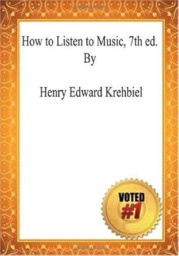

How to Listen to Music, 7th ed. (1896)
by Henry Edward Krehbiel


I have already hinted at the fact that there is an intimate relationship between the compositions usually heard at a classical concert. Symphonies, symphonic poems, concertos for solo instruments and orchestra, as well as the various forms of chamber music, such as trios, quartets, and quintets for strings, or pianoforte and strings, are but different expressions of the idea which is best summed up in the word sonata. What musicians call the "sonata form" lies at the bottom of them all - even those which seem to consist of a single piece, like the symphonic poem and overture. Provided it follow, not of necessity slavishly, but in its general structure, a certain scheme which was slowly developed by the geniuses who became the law-givers of the art, a composite or cyclical composition (that is, one composed of a number of parts, or movements) is, as the case may be, a symphony, concerto, or sonata. It is a sonata if it be written for a solo instrument like the pianoforte or organ, or for one like the violin or clarinet, with pianoforte accompaniment. If the accompaniment be written for orchestra, it is called a concerto. A sonata written for an orchestra is a symphony. The nature of the interpreting medium naturally determines the exposition of the form, but all the essential attributes can be learned from a study of the symphony, which because of the dignity and eloquence of its apparatus admits of a wider scope than its allies, and must be accepted as the highest type, not merely of the sonata, but of the instrumental art. It will be necessary presently to point out the more important modifications which compositions of this character have undergone in the development of music, but the ends of clearness will be best subserved if the study be conducted on fundamental lines.🏁
Global Leaderboard
| # | Player | Time | Duration | Accuracy | WPM | pp | |
|---|---|---|---|---|---|---|---|
| 1 | |||||||
| 2 | |||||||
| 3 | |||||||
| 4 | |||||||
| 5 | |||||||
| 6 | |||||||
| 7 | |||||||
| 8 | |||||||
| 9 | |||||||
| 10 |


I have already hinted at the fact that there is an intimate relationship between the compositions usually heard at a classical concert. Symphonies, symphonic poems, concertos for solo instruments and orchestra, as well as the various forms of chamber music, such as trios, quartets, and quintets for strings, or pianoforte and strings, are but different expressions of the idea which is best summed up in the word sonata. What musicians call the "sonata form" lies at the bottom of them all - even those which seem to consist of a single piece, like the symphonic poem and overture. Provided it follow, not of necessity slavishly, but in its general structure, a certain scheme which was slowly developed by the geniuses who became the law-givers of the art, a composite or cyclical composition (that is, one composed of a number of parts, or movements) is, as the case may be, a symphony, concerto, or sonata. It is a sonata if it be written for a solo instrument like the pianoforte or organ, or for one like the violin or clarinet, with pianoforte accompaniment. If the accompaniment be written for orchestra, it is called a concerto. A sonata written for an orchestra is a symphony. The nature of the interpreting medium naturally determines the exposition of the form, but all the essential attributes can be learned from a study of the symphony, which because of the dignity and eloquence of its apparatus admits of a wider scope than its allies, and must be accepted as the highest type, not merely of the sonata, but of the instrumental art. It will be necessary presently to point out the more important modifications which compositions of this character have undergone in the development of music, but the ends of clearness will be best subserved if the study be conducted on fundamental lines.🏁